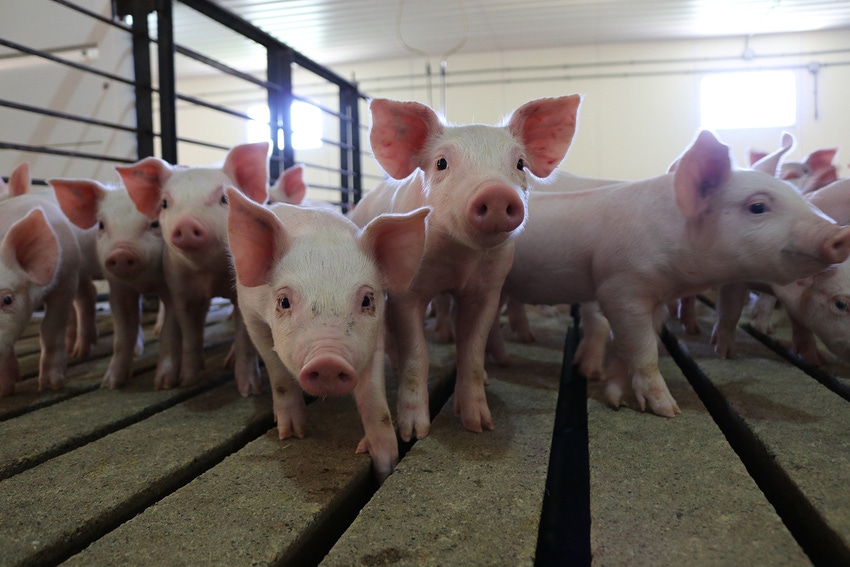Despite the evidence, Fano says there has been debate about whether a homologous vaccine could provide better protection against today’s most prevalent genotype, PCV2d.

“Small but mighty” could be an accurate description of porcine circovirus Type 2. Since the small nonenveloped circular DNA virus was discovered in the late-1990s, the pathogen continues to evolve with three major genotypes now in circulation. Because PCV2d has recently emerged as the most predominant genotype in the United States, swine industry researchers are investigating whether existing vaccines can cross protect against it.
“In terms of prevalence, PCV2a and PCV2b are in the 30-40% range and the rest is basically PCV2d, but we don’t have a clear explanation why PCV2d is the most prevalent right now,” says Eduardo Fano, senior associate director of Swine Technical Marketing at Boehringer Ingelheim. “PCV2e and PCV2c are out there, but they are very rare. It’s very difficult to find those. They pop up, but they never prevail. So, what is the difference with PCV2d? We don’t know yet.”
When PCV2d started showing up more in the industry, BI started conducting cross protection studies using its PCV2a-based vaccine. In 2015, the company first ran an exploratory study on 48 farms in the Midwestern United States. Participating farms had to meet the following criteria: the pigs were on BI’s vaccination program at weaning age; the pig owner and veterinarian were satisfied with the current vaccine; pig performance was meeting the systems’ expectations; and no clinical health issues suggested PCVAD was present on the farm.
Polymerase chain reaction testing was performed on pig serum, oral fluids and lung tissues. Out of the 48 farms, 27 were PCR-positive for PCV2, with nearly half of those being classified as PCV2d and the rest PCV2a or PCV2b.
“At that time, we were able to find PCV2d in cases where there was not an issue of PCVAD, so we were able to identify the virus there even though there was no clinical disease,” Fano says. “That means that the vaccine was working.”
After the exploratory assessment, the BI team decided to take the research one step further and conduct a side-by-side cross protection field study to test the impact of vaccination on average daily gain and mortality when PCV2d was known to be present. Weaning-age pigs were separated into three groups and administered either a one-dose bivalent PCV2 and Mycoplasma hyopneumoniae vaccine, a split-dose bivalent PCV2 and Mhp vaccine, or no vaccine. When PCV2 viremia was detected in non-vaccinated pigs, molecular testing indicated it was a PCV2d infection. There was also evidence of a porcine reproductive and respiratory syndrome challenge late in the study.
Following the study, the BI researchers concluded that the one-dose protocol was just as efficacious against a PCV2d challenge as the two-dose protocol, while reducing pig handling and stress, labor and time.
Upon these findings the BI team then conducted an experimental, highly controlled study to test the vaccine in experimental challenge conditions with several pathogens, including a PCV2d field isolate, Mhp strain 232 and PRRSV strain SDSU-73. Pigs in this study were split into two groups of 20: non-vaccinated challenged controls and pigs vaccinated with a single-dose, three-way vaccine to control PCV2, Mhp and PRRS.
Significant differences in PCV2 parameters, including lymphoid depletion, immunohistochemistry and viremia, were observed between the two groups. The vaccinated pigs also had higher average daily gain than the non-vaccinated control group.
“In that study again, we found positive results that the vaccine was working,” Fano says. “It was a very strong challenge, with 20% mortality and obvious clinical signs of respiratory disease. We were able to show efficacy against PCV2d under even those extreme conditions in this highly-controlled study, adding to the body of evidence suggesting cross-protection.”
Despite all this evidence, Fano says there was still some debate about whether a homologous PCV2d-based vaccine could provide better protection against today’s most prevalent genotype. There are some speculations that PCV2d is little bit more pathogenic and that a PCV2a-based vaccine may only have partial cross-protection.
In order to address these concerns, the team set out to test the PCV2a-based vaccine against a PCV2d-construct vaccine in an experimental challenge study. The study compared four groups of pigs challenged with PCV2d: pigs vaccinated with the PCV2a-based vaccine, pigs vaccinated with a PCV2d experimental vaccine, and two groups of non-vaccinated controls. In addition, at the time of challenge, it was determined that the pigs in this study had been naturally exposed to PCV2a following vaccination. The study found that both vaccines prevented clinical signs and mortality, while control pigs were severely affected.
“We measured efficacy by looking at the reduction of lymphoid lesions and what we found was that the two vaccines performed about the same,” Fano says. “We weren’t able to show any extra protection from the PCV2d construct vaccine versus the PCV2a-based vaccine. The PCV2a-based vaccine was cross-protective against PCV2d and the PCV2d construct vaccine was not providing any extra benefit under this study’s conditions.”
The BI team plans to keep the PCV2d cross-protection investigation moving forward, designing and conducting in-vitro studies to test serum samples coming from the field.
“Some people expect that PCV2 will keep mutating and if that happens and we run these in-vitro assessments, it’s going to be a kind of a warning system where we can identify when we are crossing the line in terms of cross-protection,” Fano says.
About the Author(s)
You May Also Like





